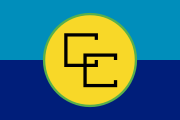Antigua and Barbuda
| Antigua and Barbuda | ||||||
|---|---|---|---|---|---|---|
|
||||||
| Motto: Each Endeavouring, All Achieving | ||||||
| Anthem: Fair Antigua and Barbuda Royal anthem: God Save the Queen 1 |
||||||
 |
||||||
| Capital (and largest city) |
Saint John's |
|||||
| Official languages | English | |||||
| Demonym | Antiguan, Barbudan | |||||
| Government | Parliamentary democracy under a federal constitutional monarchy |
|||||
| - | Head of State | Elizabeth II | ||||
| - | Governor-General | Louise Lake-Tack | ||||
| - | Prime Minister | Baldwin Spencer | ||||
| Independence from the United Kingdom | ||||||
| - | Date | November 1, 1981 | ||||
| Area | ||||||
| - | Total | 280 km2 (198th) 108 sq mi |
||||
| - | Water (%) | negligible | ||||
| Population | ||||||
| - | 2008 estimate | 84,522+ (191th) | ||||
| - | Density | 184/km2 (57) 394/sq mi |
||||
| GDP (PPP) | 2007 estimate | |||||
| - | Total | $1.527 billion[1] | ||||
| - | Per capita | $18,352[1] | ||||
| GDP (nominal) | 2007 estimate | |||||
| - | Total | $1.088 billion[1] | ||||
| - | Per capita | $13,079[1] | ||||
| HDI (2007) | ▲ 0.815 (high) (57th) | |||||
| Currency | East Caribbean dollar (XCD) |
|||||
| Time zone | AST (UTC-4) | |||||
| Drives on the | left | |||||
| Internet TLD | .ag | |||||
| Calling code | 1 268 | |||||
| 1 | God Save The Queen is officially a national anthem but is generally used only on regal and vice-regal occasions. | |||||
Antigua and Barbuda (Spanish for "Ancient" and "Bearded") is an island nation located on the eastern boundary of the Caribbean Sea with the Atlantic Ocean. As its name suggests, it consists of two major islands – Antigua (IPA: /ænˈtiːgə/) and Barbuda (/bɑrˈbjuːdə/) – as well as a number of smaller islets. All are close neighbours within the middle of the Leeward Islands and roughly 17 degrees north of the equator.
Antigua has a population of 82,000, comprised chiefly of a mixture of people of West African, British and Portuguese descent. The islands of Antigua and Barbuda are part of the Lesser Antilles archipelago. To the south of Antigua and Barbuda lie the islands of Guadeloupe, Dominica, Martinique, Saint Lucia, Saint Vincent and the Grenadines, Barbados, Grenada and Trinidad and Tobago. Montserrat lies to the southwest; Saint Kitts and Nevis and Saint Eustatius are to the west, and Saint Barthélemy, Saint Martin and Anguilla are to the northwest.
Contents |
History
Antigua was first settled by pre-agricultural Amerindians known as "Archaic People," commonly referred to as Ciboney, which means cave dweller in Arawakan. The earliest settlements on the island date to 2900 BC. They were succeeded by ceramic-using agriculturalist Saladoid people who migrated up the island chain from Venezuela. They were later replaced by Arawakan speakers, and around 1500 [BC?] by Island Caribs.
The Arawaks were the first well-documented group of Antiguans. The Arawaks called Antigua Wadadli, which means land of oil, perhaps a reference to eucalyptus oil extracted from eucalyptus trees. They paddled to the island by canoe (piragua) from Venezuela, ejected by the Caribs--another people indigenous to the area. Arawaks introduced agriculture to Antigua and Barbuda, raising, among other crops, the famous Antiguan "Black" pineapple. They also cultivated various other foods including: corn sweet potatoes (White with firmer flesh than the bright orange "sweet potato" used in the United States.) chiles guava tobacco cotton Some of the vegetables listed, such as corn and sweet potatoes, still play an important role in Antiguan cuisine.
For example, a popular Antiguan dish, Dukuna (DOO-koo-NAH) is a sweet, steamed dumpling made from grated sweet potatoes, flour and spices. In addition, one of the Antiguan staple foods, fungi (FOON-ji), is a cooked paste made of cornmeal and water.
The bulk of the Arawaks left Antigua about 1100 A.D. Those who remained were subsequently raided by the Caribs. According to the Catholic Encyclopedia, the Carib's superior weapons and seafaring prowess allowed them to defeat most Arawak nations in the West Indies--enslaving some, and cannibalizing others.
The Catholic Encyclopedia does make it clear that the European invaders had some difficulty identifying and differentiating between the various native peoples they encountered. As a result, the number and types of ethnic/tribal/national groups in existence at the time may be much more varied and numerous than the two mentioned in this Article.
According to A Brief History of the Caribbean (Jan Rogozinski, Penguin Putnam, Inc September 2000 ), European and African diseases, malnutrition and slavery eventually destroyed the vast majority of the Caribbean's native population. No researcher has conclusively proven any of these causes as the real reason for the destruction of West Indian natives. In fact, some historians believe that the psychological stress of slavery may also have played a part in the massive number of native deaths while in servitude. Others believe that the reportedly abundant, but starchy, low-protein diet may have contributed to severe malnutrition of the "Indians" who were used to a diet fortified with protein from sea-life.
The Indigenous West Indians made excellent sea vessels that they used to sail the Atlantic and Caribbean. As a result, Caribs and Arawaks populated much of South American and the Caribbean Islands. Relatives of the Antiguan Arawaks and Caribs still live in various countries in South America, notably Brazil, Venezuela and Colombia. The smaller remaining native populations in the West Indies maintain a pride in their heritage.
The island of Antigua was named Wadadli by these natives and is today called Land of Wadadli by locals. Christopher Columbus landed on his second trip in 1493 and named the island Santa Maria de la Antigua after a church in Seville, Spain. Early settlement by the Spanish was replaced by English rule from 1632 (British rule from 1707 Acts of Union), with a French interlude in 1666. Slavery, established to run the sugar plantations on Antigua, was abolished in 1834.
The islands became an independent state within the Commonwealth of Nations on November 1, 1981, with Elizabeth II as the first Queen of Antigua and Barbuda and the Right Honourable Vere Cornwall Bird became the first prime minister.
Politics
The politics of Antigua and Barbuda takes place in a framework of a federal parliamentary representative democratic monarchy, whereby the Head of State is the monarch, who appoints the Governor-General as vice-regal representative. In 2007 Louise Lake-Tack became the first female to hold the position of Governor-General in the history of Antigua and Barbuda. A Council of Ministers is appointed by the Governor-General on the advice of the Prime Minister, currently Baldwin Spencer. The Prime Minister is the head of the government. Vere Cornwall Bird, Antigua and Barbuda's first Prime Minister, is credited with having brought Antigua and Barbuda and the Caribbean into a new era of independence.
Executive power is exercised by the government. Legislative power is vested in both the government and the two chambers of the Parliament. The bicameral Parliament consists of the Senate (seventeen-member body appointed by the governor general) and the House of Representatives (seventeen seats; members are elected by first past the post to serve five-year terms). The last elections held were on 23 March 2004, while the next are due in 2009. At the last elections, the Antigua Labour Party won four seats, while the United Progressive Party won thirteen.
Since 1949, the party system had been dominated by the personalist Antigua Labour Party. However, the Antigua and Barbuda legislative election, 2004, saw the defeat of the longest-serving elected government in the Caribbean. The Prime Minister, Lester Bryant Bird and deputy Robin Yearwood had been in office since 1994, when he succeeded his father, Vere Bird. The elder Bird had been Prime Minister from independence in 1981 and, before independence, had been Chief Minister of Antigua from 1960, except for the period 1971-76 when the Progressive Labour Movement (PLM) defeated them in those elections.
The Judicial Branch is the Eastern Caribbean Supreme Court (based in Saint Lucia; one judge of the Supreme Court is a resident of the islands and presides over the Court of Summary Jurisdiction). Antigua is also a member of the Caribbean Court of Justice. The Supreme Court of Appeal was the British Judicial Committee of the Privy Council up until 2001, when the nations of the Caribbean Community voted to abolish the right of appeal to the Privy Council in favour of a Caribbean Court of Justice. Some debate between member countries had repeatedly delayed the court's date of inauguration. As of March, 2005, only Barbados was set to replace appeals to the Privy Council with appeals the Caribbean Court of Justice, which then had come into operation.
Military
The Royal Antigua and Barbuda Defence Force is the country's armed force. It has 185 members.
Parishes and dependencies
The island of Antigua is divided into six parishes:
|
 |
The island of Barbuda (1,241) and the uninhabited island of Redonda each enjoy dependency status.
The capital is the city of St. John's (population 21,514).
Geography
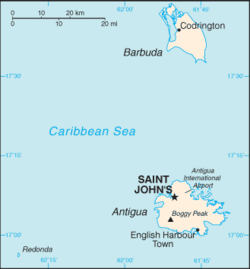
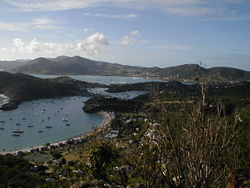
The country consists of a number of islands, of which Antigua is the largest and most populous. Barbuda, just north of Antigua, is the other main island. The islands have a warm, tropical climate, with nearly constant temperatures throughout the year. Redonda, another nearby island, which was annexed in the 1860s when its phosphate resources were discovered, is also the territory of Antigua and Barbuda although it has been unoccupied since 1930.
The islands are mostly low-lying with the highest point being Boggy Peak recently renamed Mount Obama by the Country's Prime Minster, at 402 metres (1,319 ft). The small country's main town is the capital, Saint John's, on Antigua; Barbuda's largest town is Codrington. Antigua & Barbuda combined have 365 beaches.
The Antiguan Racer is the rarest snake in the world with approximately only two hundred remaining in the wild. It is found on Bird Island, an island off the coast of Antigua.
Economy
Tourism dominates the economy, accounting for more than half of the GDP. Antigua is famous for its many exclusive luxury resorts. Weak tourist arrival numbers since early 2000 have slowed the economy, however, and pressed the government into a tight fiscal corner.
Investment Banking and Financial Services also comprise an important part of the economy. Major world banks with offices in Antigua include: Barclays, Royal Bank of Canada (RBC), and Scotia Bank among others.
The dual-island nation's agricultural production is focused on the domestic market and constrained by a limited water supply and a labour shortage stemming from the lure of higher wages in tourism and construction work.
Manufacturing comprises enclave-type assembly for export with major products being bedding, handicrafts, and electronic components. Prospects for economic growth in the medium term will continue to depend on income growth in the industrialised world, especially in the United States, which accounts for about one-third of all tourist arrivals.
Demographics
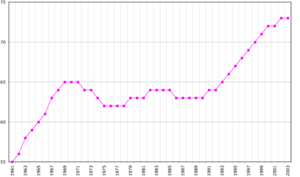
The ethnic distribution consist of 91% Black or Mulatto, 4.4% Other Mixed Race, 1.7% White, 2.9% Other. The majority of the white population is ethnically Irish and British, and Portuguese. There are also Christian Levantine Arabs (primarily of Syrian, Lebanese and Palestinian descent) and a small population of Asians and Sephardic Jews.
Behind the late twentieth century reviving and respecifying of the place of Afro-Antiguans and Barbudans in the cultural life of the society, is a history of race/ethnic relations that systematically excluded them. Within the colonial framework established by the British soon after their initial settlement of Antigua in 1623, five distinct and carefully ranked race/ethnic groups emerged. At the top of this hierarchy were the British, who justified their hegemony with arguments of white supremacy and civilizing missions. Among themselves, there were divisions between British Antiguans and noncreolized Britons, with the latter coming out on top. In short, this was a race/ethnic hierarchy that gave maximum recognition to Anglicized persons and cultural practices.
Immediately below the British were the mulattos, a mixed race group that resulted from unions between black Africans and white Europeans. Mulattos were lighter in shade than the masses of black Africans, and on that basis distinguished themselves from the latter. They developed complex ideologies of shade to legitimate their claims to higher status. These ideologies of shade paralleled in many ways British ideologies of white supremacy.
Next in this hierarchy were the Portuguese — twenty-five hundred of whom migrated as workers from Madeira between 1847 and 1852 because of a severe famine. Many established small businesses and joined the ranks of the mulatto middle class. The British never really considered Portuguese as whites and so they were not allowed into their ranks. Among Portuguese Antiguans and Barbudans, status differences move along a continuum of varying degrees of assimilation into the Anglicized practices of the dominant group.
Below the Portuguese were the Middle Easterners, who began migrating to Antigua and Barbuda around the turn of the twentieth century. Starting as itinerant traders, they soon worked their way into the middle strata of the society. Although Middle Easterners came from a variety of areas in the Middle East, as a group they are usually referred to as Syrians.

Fifth and finally were the Afro-Antiguans and Barbudans who were located at the bottom of this hierarchy. Forced to "emigrate" as slaves, Africans started arriving in Antigua and Barbuda in large numbers during the 1670s. Very quickly they came to constitute the majority of the population. As they entered this hierarchy, Africans were profoundly racialized. They ceased being Yoruba, Igbo, or Akan and became Negroes or Blacks.
In the 20th century, the colonial hierarchy gradually began to be subversed as a result of universal education and better economic opportunity. This process gave rise to blacks reaching the highest strata of society and government.
In the last decade, Spanish-speaking immigrants from the Dominican Republic and Afro-Caribbean immigrants from Guyana and Dominica have been added to this ethnic mosaic. They have entered at the bottom of the hierarchy and it is still too early to predict what their patterns of assimilation and social mobility will be.
Today, an increasingly large percent of the population live abroad, most notably in the United Kingdom (Antiguan Britons), United States and Canada. A minority of the Antiguan residents are immigrants from other countries, particularly Dominica, Guyana and Jamaica with an increasing number of immigrants from the Dominican Republic, St. Vincent and the Grenadines and Nigeria. There is also a significant population of American citizens estimated at 4500 people which would make it one of the largest American citizen populations in the English speaking Eastern Caribbean.[2]
A sizable majority of Antiguans are Christians (74%),[3] with the Anglican Church (about 44%) being the largest denomination. Catholicism is the other significant denomination, with the remainder being other Protestants: including Methodists, Moravians, Pentecostals and Seventh-Day Adventists. There are also Jehovah's Witnesses. Non-Christian religions practiced on the islands include Rastafari, Islam, Judaism, and Baha'i.
Languages
The official language of Antigua and Barbuda is English, but many of the locals speak Antiguan Creole. The Barbudan accent is slightly different from the Antiguan one. Spanish is also widely spoken in certain communities in Antigua where immigrants from the Dominican Republic make up large numbers.[4]
In the years before Antigua and Barbuda's independence, Standard English was widely spoken in preference to Antiguan Creole, but afterwards Antiguans began treating Antiguan Creole as a respectable aspect of their culture. Generally, the upper and middle classes shun Antiguan Creole. The educational system dissuades use of Antiguan Creole and instruction is done in Standard (British) English. The higher up one goes on the socio economic ladder, the less prevalent Antiguan Creole becomes, to the extent that some Antiguans will even deny that they speak or understand Antiguan Creole.
Many of the words used in the Antiguan dialect are derived from British and also African origins. This can be easily seen in some phrases like: "Me nah go" meaning "I am not going". Another example is: "Ent it?" meaning "Ain't it?" which is in itself dialect and means "Isn't it?". Common island proverbs often can be traced to Africa.
Culture
The culture of Antigua and Barbuda is predominantly British, and this is evident throughout many aspects of the society. For example, the national sport is cricket, and Antigua has produced several famous cricket players including Sir Vivian Richards, Anderson "Andy" Roberts, and Richard "Richy" Richardson. Following cricket, the next most popular sport is soccer, which is called football in Antigua.
American popular culture and fashion also have a heavy influence. The majority of the media in the country are major United States networks. Antiguans pay close attention to American fashion trends, and major designer items are available at boutiques in St. John's and elsewhere, although many Antiguans prefer to make a special trip to North America, or San Juan, Puerto Rico, for shopping.
Family and religion play an important role in the lives of Antiguans. Most Antiguans attend religious services on Sunday, although there is a growing minority of Seventh-day Adventists who observe the Sabbath on Saturday.
There is a national Carnival celebration held during August each year. Historically, Carnival commemorates the abolition of slavery in the British West Indies, although on some islands, carnival celebrates the end of Lent. The annual Carnival includes pageants, shows, contests and festive activities and is a notable tourist attraction.
Calypso and soca music are important in Antigua and Barbuda
- See also: Cuisine of Antigua and Barbuda and Music of Antigua and Barbuda
Media
There are two daily newspapers: Daily Observer, and Antigua Sun which also publishes newspapers on other Caribbean islands. Most American television networks are available in addition to the local face television ABS TV 10 which is the only stations that show 100% local shows. There are several local and regional radio stations.
Sport
- See also: Cricket in the West Indies
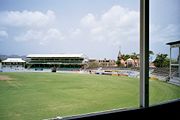
Like many commonwealth countries, cricket is the most popular sport. The 2007 Cricket World Cup was hosted in the West Indies from 11 March to 28 April 2007. Antigua hosted eight matches at the Sir Vivian Richards Stadium, which was completed on 11 February 2007 and can hold up to 20 000 people at full capacity. Antigua is also a Host of Stanford Twenty20 - Twenty20 Cricket, a version started by Allen Stanford in 2006 as a regional cricket game with almost all Caribbean islands taking part. Viv Richards is from Antigua and scored the fastest Test Century and Brian Lara twice scored the World Test Record at Antigua Recreation Ground.
Association football is also a very popular sport. Antigua has a national football team although it is inexperienced.
Athletics is also popular. Talented athletes are trained from a young age and Antigua and Barbuda have produced a few fairly adept athletes. Janill Williams, a young athlete with much promise comes from Gray's Farm, Antigua. Also, Sonia Williams and Heather Samuel have represented Antigua and Barbuda at the Olympic Games. Others prominent rising stars include Brendan Christian (100 m, 200 m), Daniel Bailey (100 m, 200 m) and James Grayman (High Jump).
Education
The people of Antigua & Barbuda have a high level of literacy at well over 90%. In 1998, Antigua and Barbuda adopted a national mandate to become the preeminent provider of medical services in the Caribbean. As part of this mission, Antigua and Barbuda is building the most technologically advanced hospital in the Caribbean, the Mt. St. John Medical Centre. The island of Antigua currently has two medical schools, the American University of Antigua (AUA),[5] founded in 2004 and The University of Health Sciences Antigua (UHSA),[6] founded in 1982.
There is also a government owned state college in Antigua as well as the Antigua and Barbuda Institute of Information Technology (ABIIT). The University of the West Indies has a branch in Antigua for locals to continue University studies.
Antigua has a number of international schools the foremost of which is CCSET International Academy
Foreign relations
Antigua and Barbuda is a member of the United Nations, the Commonwealth of Nations, Caribbean Community, Organisation of Eastern Caribbean States, Organization of American States, World Trade Organization and the Eastern Caribbean's Regional Security System.
Antigua and Barbuda is also a member of the International Criminal Court (with a Bilateral Immunity Agreement of protection for the US-military as covered under Article 98).
See also
|
||||||||||||||||||||
- Antiguan British
References
- ↑ 1.0 1.1 1.2 1.3 "Antigua and Barbuda". International Monetary Fund. Retrieved on 2008-10-09.
- ↑ "Background Note: Antigua and Barbuda". Retrieved on 2007-08-23.
- ↑ "Antigua and Barbuda: International Religious Freedom Report 2006" (2006-09-15). Retrieved on 2007-08-23.
- ↑ Farquhar, Bernadette. "The Spanish Language in Antigua and Barbuda: Implications for Language Planning and Language Research". Retrieved on 2007-08-23.
- ↑ "American University of Antigua, College of Medicine". Retrieved on 2007-08-23.
- ↑ "University of Health Sciences Antigua". Retrieved on 2007-08-23.
Liberta Village, Antigua
External links
- Government
- The Official Website of the Government of Antigua and Barbuda
- Antigua & Barbuda, its Department of Tourism website
- Antigua and Barbuda, United States Library of Congress Portals on the World
- Governments on the WWW: Antigua and Barbuda
- Country Data
- Antigua and Barbuda entry at The World Factbook
- Antigua and Barbuda from UCB Libraries GovPubs
- Antigua and Barbuda at the Open Directory Project
- World Bank's country data profile for Antigua and Barbuda
- Worldwide Governance Indicators
- World Intellectual Property Handbook: Antigua and Barbuda
- Other
- The High Commission of Antigua and Barbuda. Tourism, business, history and culture, politics - an up to date website.
- Antigua Carnival - with photo galleries.
- American University of Antigua - a hospital integrated medical school in Caribbean.
- Health Sciences library - Library of American University of Antigua
- Recipes to many Antiguan dishes
- Video of Antigua and Barbuda
|
|
|||||||||||||||||||||||||||||||||||||||||||||||||||||||||||||||||
|---|---|---|---|---|---|---|---|---|---|---|---|---|---|---|---|---|---|---|---|---|---|---|---|---|---|---|---|---|---|---|---|---|---|---|---|---|---|---|---|---|---|---|---|---|---|---|---|---|---|---|---|---|---|---|---|---|---|---|---|---|---|---|---|---|---|
|
|||||||||||||||||||||||||||||||||||||||||||||||||||||||||||||||||
|
|||||||||||
|
||||||||


